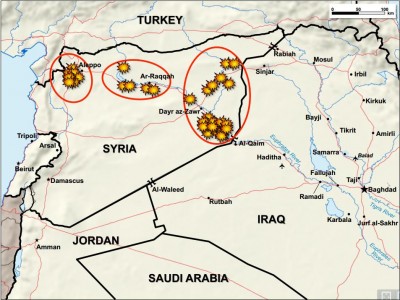Supported by Russian Air Strikes: The Syria-Iraq Ground Offensive against US Sponsored ISIS Terrorists
International Military Review & Analysis

Since October 10, Russia’s air force in Syria continued to hit terrorists’ targets conducting from 33 to 88 sorties per day.
Russian air strikes were performed in the provinces of Raqqah, Hama, Damascus, Aleppo, Latakia, Idlib, Homs, Deir ez-Zor. Since the start of the operation, Russian air raids have destroyed more than 380 sites of ISIS.
The last days have shown that ISIS militants have serious air defense assets. On October 15, Russian warplanes destroyed the air defense system “Osa” at the village of Eastern Guta around Damascus.
In northern Syria, the pro-government forces consist of 60 000-strong grouping officially strengthened by Russian military equipment and weapons.
SouthFront: Analysis & Intelligence has information that units of the Syrian Arab Army (SAA) have been bolstered by Russian military advisers, down to squad level in some artillery and special units.
In Aleppo province, the SAA and its allies are seeking to lift the siege from the Kuweires Military Airport. On October 10 the SAA “Tiger forces” took control of the town of Jabboul. On October 15, the pro-government units captured the village of Tal Naam. On October 16, the villages of Qala’at yAl-Najam, Abtayn were controlled by the SAA. At the moment the Syrian forces are clashing with militants in approximately 6.2km from the airport.
At least, 235 Jabhat al Nusra militants have been killed since the start of the Syrian advance in Hama province. The strategic towns of Al-Mansoura and al-Lihaya came under control of the Syrian government. Also, the SAA captured the towns of Tal Sekik and Foru.
It became known that Hezbollah commander, Hassan Hossein Al-Hadj, has died during the clashes for the city of Mansura in the Idlib province. The SouthFront: Analysis & Intelligence sources report, Hezbollah units fighting against terrorists in Syria has received reinforcements and additional supplies of arms and equipment. This is a result of the growing role of Hezbollah and Iran-backed militia groups at the Syrian battlespace. As result of the heavhy clashes against Jabhat al Nusra, the Syrian forces captured the southtern part of the city of Kafr Nabudah.
The pro-government forces’ advance is aimed on the strategic town of Khan Shaykhun olcated at the highway linking Damascus and Aleppo.
In Latakia province, Syrian forces supported by Russian warplanes pushed al Nusra militant s from Kafr Dalba and took control of the sector. Then, SAA and allies captured the villages of Salma and Jeb al-Ahmar. The ISIS militants were located in these areas. At the moment, Russian warplanes and the Syrian army units are moping up the area from the separate militant units.
In Homs province, the Syrian forces are conducting military actions against Jabhat Al Nusra and ISIS. The center of clashes is the Al-Rastan area. Russian and Syrian warplanes work against terrorist there actively. Also, heavy clashes were observed at Rasm al `Abd and Habra al-Garbia. The Jabhat Al Nusra militants are using anti-tank missile systems “TOW” supplied by Saudi Arabia.
Jabhat al Nusra militants are massively fleeing from the province Daraa to Jordan. The Syrian forces are advancing in the sector of the town of Mahaja. Jabhat al Nusra has lost dozens of militants in the clashes there.
Separately, Iraqi forces started a full-scale offensive against ISIS in the province of Anbar. It borders with Syria. According to the SouthFront: Analysis & Intelligence sources this fact is directly related to the cooperation among Russia, Iran, Syria and Iraq launched trough the joint information center in Baghdad.
On October 11, Abu Bakr al-Baghdadi was reportedly injured as result of the airstrike in the Anbar province of Iraq. On October 14, Irainian media reported that Abu Bakr al-Baghdadi was under treatment in Turkey. The US Central Intelligence Service and Turkish special services assisted him in this.
Russia has been continuing to supply weapons and equipment to the Syrian forces. According to reports, the Russian heavy flamethrower systems TOS-1A “Solntsepek” are in Syria. They will be used in the Syrian forces’ offensive actions over the country.
The security of the Russian naval facility in Tartus was strengthened. The guard units received additional military equipment and number of reinforcements. A marine infantry battalion of the Russian Black Sea fleet is a main force there. Russia is exercising preparatory works to increase logistical capabilites of the naval facility. 10 additional container ships and tankers will be reportedly used to expand supplies to Tartus.
The main result of the recent success of the Syrian forces have raised the pro-government forces’ morale. The future developments will strongly depend on the Syrian force’s capacity to hold gained momentum and to coordinate its actions with the Russian air efforts. In any case, the active phase of the offensive will end in next 1-2 weeks. Then Syrian forces will need to strengthen captured position, get additional supplies and rest.

